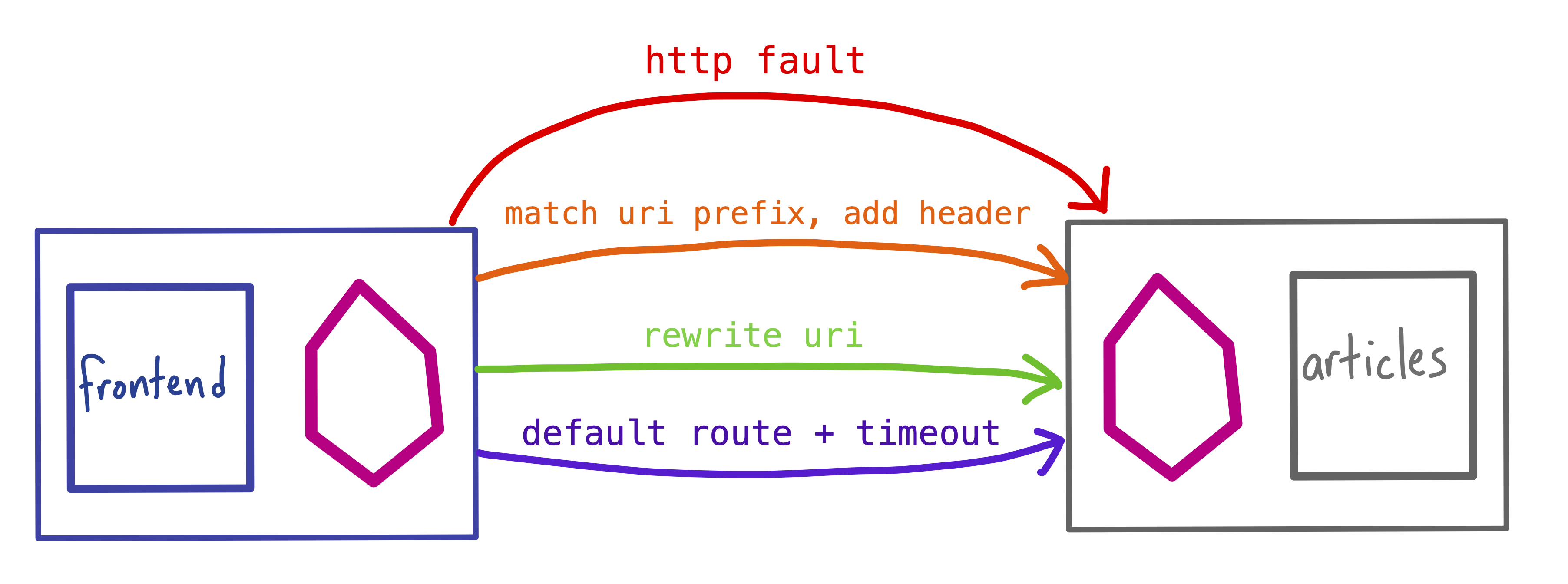Istio supports lots of traffic management use cases, from redirects and traffic splitting to mirroring and retry logic. If you’ve created an Istio VirtualService to define one of these policies for a service, it’s easy to add more traffic management rules to the same resource. This example demonstrates how to apply multiple traffic rules to one Kubernetes-based service.
Let’s say that we’re on the frontend engineering team for a newspaper’s website. The user-facing frontend service relies on a backend called articles, which serves article content and metadata as JSON. But the articles team is refactoring the service in a new language, and they’re frequently rolling out new changes. This has resulted in unexpected errors in the frontend, which relied on the behavior of the legacy articles service. To complicate things, the newspaper’s blog, previously served by a separate blog service, was just incorporated into the articles service. Now, all blog posts are articles, served with the /beta/blog path.
In order to lock in the behavior of articles on behalf of the frontend, we’ll create an Istio traffic policy for articles. The frontend’s traffic requirements for articles include: returning a no-cache header for any /breaking-news article, rewriting /blog to /beta/blog, and enforcing a 2-second timeout on every request.
To get this aggregate functionality, we’ll create one VirtualService for articles, with three http rules: header modification for /breaking-news, URL rewrite for /blog, and a default fallthrough to the articles service. All three rules have a 2-second timeout.
apiVersion: networking.istio.io/v1alpha3
kind: VirtualService
metadata:
name: articles-vs
spec:
hosts:
- articles
http:
- match: # RULE 1 - BREAKING NEWS
- uri:
prefix: "/article/breaking-news"
route:
- destination:
host: articles
headers:
response:
add:
no-cache: "true"
timeout: 2s
- match: # RULE 2 - BLOG URI REWRITE
- uri:
prefix: /blog
rewrite:
uri: /beta/blog
route:
- destination:
host: articles
timeout: 2s
- route: # RULE 3 / DEFAULT - TIMEOUT
- destination:
host: articles
timeout: 2s
weight: 100
After applying this VirtualService to the cluster, we can exec into the frontend pod and access the articles service, to verify that the rules are taking effect. For instance, if we request a /breaking-news article, we’ll see the no-cache:true header added to the response:
$ curl -v http://articles:80/article/breaking-news/2020/astrophysics-discovery
< HTTP/1.1 200 OK
< date: Wed, 15 Jan 2020 22:10:52 GMT
...
< no-cache: true
If we request a path starting with /blog, that gets rewritten to /beta/blog, and articles knows to serve the /beta/blog path:
$ curl http://articles:80/blog/2020/new-engineering-blog
{"id":91385,"title":"Welcome to the new News Blog!" ...
And finally, if we write in a 10-second sleep into the article service’s application code, we can see our 2-second timeout in action:
$ curl http://articles:80/
upstream request timeout
Note: When you add multiple rules to one VirtualService, the rules are evaluated in order, from top to bottom. So if we add a fault injection rule to the articles VirtualService to return HTTP status code 404: Not Found on all requests, that rule will override the other three, taking down the entire articles service:
curl -v http://articles:80
...
* Connected to articles (10.0.21.31) port 80
< HTTP/1.1 404 Not Found
Because of this rule precedence for VirtualServices, it’s important to validate and test complex Istio traffic policies. It’s also a good idea to add a “fallthrough” or default rule, as we did above, to ensure that all requests for a specific host get routed.



